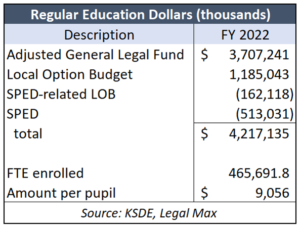School districts are hammering legislators for underfunding special education, but the Kansas Department of Education formula doesn’t seem to count all of the money. Given credit for all funding, school districts are being reimbursed for 103.4% of total costs this year and 98.7% next year.
There seem to be several issues with the formula in statute at K.S.A. 72-3422. First, the calculation of regular education aid includes deductions for transportation aid, bilingual aid, career and technical education, and at-risk funding. But Craig Neuenswander, Deputy Commissioner for Finance at KSDE, says, “SPED students are eligible for weightings. I don’t know the rationale behind the law for the weightings.”
Full credit for Local Option Budget funding related to SPED also seems to be excluded from the formula.
 The adjacent table calculates the per-pupil allocation for regular education this year. It starts with districts’ General Fund and LOB funding, as found in the KSDE Legal Max file. Next, deductions are made for special education funding as agreed upon at the Consensus Education Meeting, and 31.6% of the LOB that is attributable to special education.
The adjacent table calculates the per-pupil allocation for regular education this year. It starts with districts’ General Fund and LOB funding, as found in the KSDE Legal Max file. Next, deductions are made for special education funding as agreed upon at the Consensus Education Meeting, and 31.6% of the LOB that is attributable to special education.
Finally, divide the estimated FTE enrollment into the $4.2 billion net amount of regular education to arrive at $9,056 per student.
That’s not all of the funding. The statute only addresses General Fund and LOB, but the state also provides aid for capital outlay, bond and interest, KPERS, and a few other items.
 Total state and federal funding provided for SPED this year is, therefore, $1.115 billion. That includes $9,056 for each of the 29,000 FTE special education students, SPED aid of $513 million, the SPED-related LOB of $162 million, and all the federal assistance and state hospital administration costs provided by KSDE.
Total state and federal funding provided for SPED this year is, therefore, $1.115 billion. That includes $9,056 for each of the 29,000 FTE special education students, SPED aid of $513 million, the SPED-related LOB of $162 million, and all the federal assistance and state hospital administration costs provided by KSDE.
KSDE estimates that total special education spending this year will be $1.079 billion. So compared to all of the state and federal funding provided, school districts are reimbursed for 103.3% of their spending.
Regular aid for FY 2023 assumes the same 3% increase in the KSDE calculation.
State law calls for schools to be reimbursed for 92% of “excess costs” not covered by federal funding.
Audit needed to determine the accurate amount of SPED accounting
The formula presumes that every dollar spent on special education is recorded correctly, but there is good reason to question the validity of school districts’ accounting.
A 2019 audit of At-Risk funding concluded that most of the spending they examined “was used for teachers and programs for all students and did not appear to specifically address at-risk students as required by state law.” The 2019 audit results and education officials’ cavalier reaction indicate that the Legislature should conduct a SPED audit on spending. And while they’re at it, auditors should re-examine at-risk expenditures to see if schools are still violating state law.





